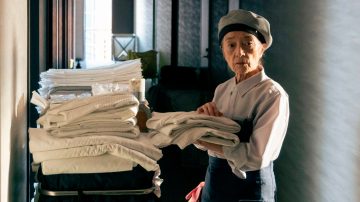
January has dawned and, for better or worse, the forced fun and merriment are at an end. With the glitter wiped clean and the party dresses put away, TV reminds us it deals in the misery business.
To some, this is a welcome antidote to happy families or those faking a perfect Christmas for Instagram in matching pyjamas. You’d think a ghost story would be about as far removed from Hallmark Christmas movie schmaltz as possible, but fear lies at the heart of our festivities.
The oral tradition of telling ghost stories during the long midwinter nights is ancient, communities entertaining themselves when it was too dark to work. In the Victorian era, with higher literacy rates, these stories were printed and proved popular for family and friends to read aloud at Christmas. Charles Dickens wrote several ghost stories, the most famous being A Christmas Carol, with his cast of four ghosts (five, if you use The Muppet Method, which is, of course, correct). There’s a darkness in our most treasured British Christmas story, a wintery shiver, and a thankfulness; there but for the grace of God go I.
Dickens, who did so much to popularise Christmas, is far from cosy. His writing shined a spotlight on inequality, grinding poverty and the failing system of Victorian workhouses. Keep an eye out for the most authentic adaptations where the jolly giant Ghost of Christmas Present reveals his tiny tragic companions; the street children named Ignorance and Want, the victims of Scrooge’s greed.

The BBC anthology series A Ghost Story for Christmas builds on this tradition with famous British horror writers brought to the small screen at Christmas. The original 1970s series was revived in 2005; that run included the pant-wettingly terrifying adaptation of ‘Oh Whistle and I’ll Come To You, My Lad’ by M. R. James. After all that sickly sweet Christmas fare, these half-hour horrors are a little acidic jolt to the senses.
Fear is deeply personal, as complicated as thrashing out what makes a good joke, so invariably there are complaints that these shows aren’t scary enough, despite them often being helmed by Mark Gatiss, the current king of small-screen fright. Contrary to online commentators, I’d argue that this year’s Count Magnus was very good (Jason Watkins is excellent in everything). Last year’s The Mezzotint was the weaker of the two. Never do a well-lit full-screen reveal of your monster. It’s always going to be less fearsome than the audience’s imagination.
This tradition of a welcome scare continues with thrillers that turn up in the schedules this time of year. Like fear, we experience thrills as a rush of adrenaline, and then a lovely release of endorphins and dopamine. While we might not need any more dopamine than Christmas already provides, we could certainly do with the adrenaline boost. Some unsettling, edge-of-your-seat stuff set against the relentless, suffocating good cheer. What makes the new year better than seeing Jamie Dornan crawl away from a severe car accident in The Tourist or Adrian Lester’s disembodied hand flung across a car park in Trigger Point? For auld lang syne, my dear, for auld lang syne.
It’s not just prestige dramas that deal with misery at the end of the year. British soaps, EastEnders especially, are notorious for an unhappy Christmas. Not just faking a smile over a terrible present or saying thanks for a dry turkey dinner, but fist fights, divorces, arrests, accidents and deaths, with high emotions, often building for weeks, eventually bubbling over. Christmas in Walford isn’t a time for peace on earth and goodwill to all men. It’s a time for crisis. Eastenders writer Tony Jordan created Dickensian as a Christmas treat in 2015, essentially a heady mix of Dickens’ characters and soap writing. It split the critics at the time, but seek it out if you can.
Top of my wish list this year is the BBC’s return to Happy Valley, one of the least cheerful places on earth. Sarah Lancashire stars as Catherine Carwood, the nucleus of her dysfunctional family. Themes of addiction, sex work, rape, murder and suicide butt against each other in Sally Wainwright’s claustrophobic Halifax. Tommy Lee Royce (arguably the most malevolent James Norton has ever been) refuses to leave town after serving time for violent crimes, determined to have a relationship with his son Ryan, who is Catherine’s grandson. Ryan is a child of rape. It’s as grim as granite, but Wainwright’s skilful writing and the warmth that Sarah Lancashire and Siobhan Finneran (as Catherine’s alcoholic sister) bring to their characters thaws the chill.
2021’s Emmy-award-winning Mare of Easttown is Happy Valley transposed to small-town America and owes its sister show a debt of gratitude. I’m delighted that our six-year wait is over, and we’re finally back in the valley.
The Christmas holidays are peak sofa season. The streaming services want to convert your free trial to a lucrative rolling subscription, and the linear channels want to grab you with their new dramas and keep you loyal until Easter at the earliest. A bit of what you fancy does you good, and if that’s gloom, ghosts or grizzly crime, TV has you covered.
With upheaval and challenges beyond our control, with bleak forecasts for an unsettled and unpleasant 2023, New Year is a scarier time than many let on. New beginnings invariably mean the death of the old. When fear of the future makes you anxious, embracing the new with optimism can be daunting in the extreme. So hunker down and control what you can; embrace the fear via fiction and be grateful for your real-life cosiness and comfort, whatever that looks like.



